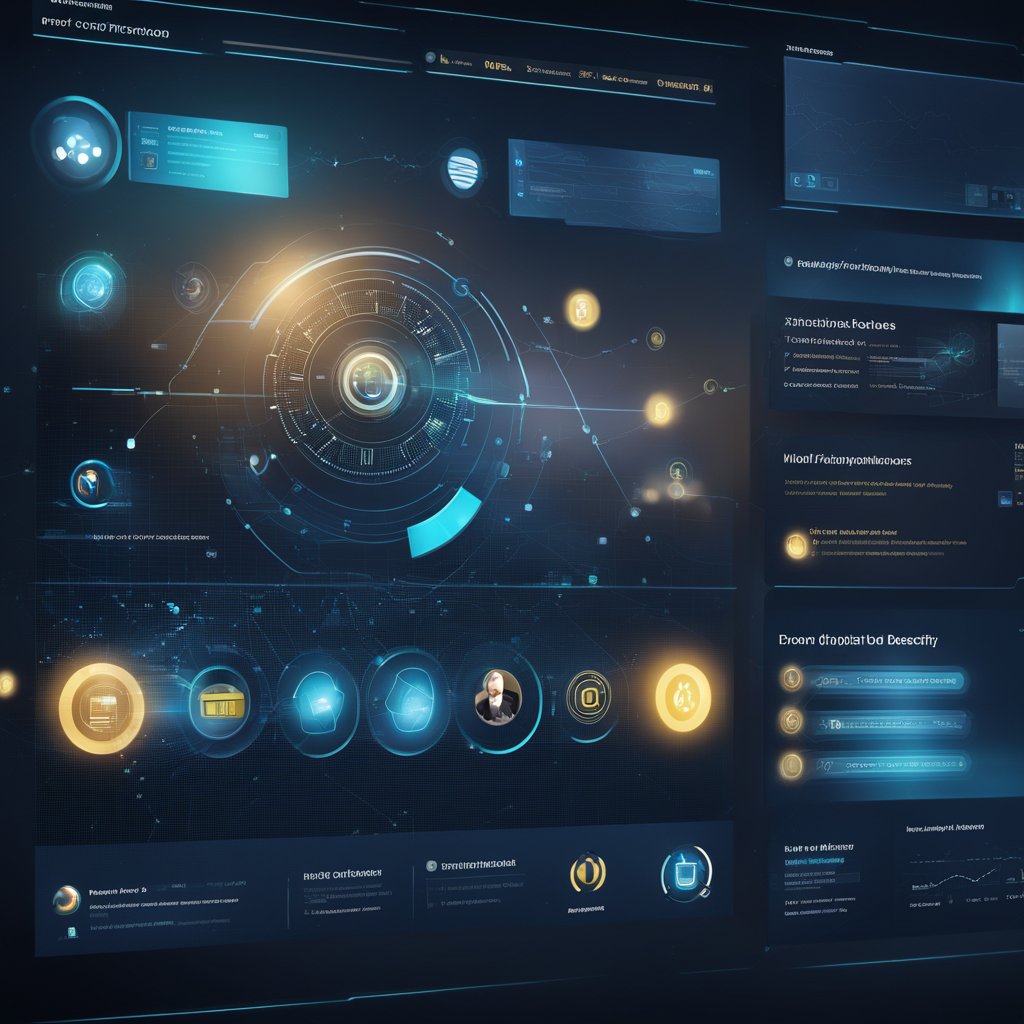Table of Contents
Website design keeps changing as technology and user needs evolve. In 2025, designers face new challenges and opportunities to create engaging online experiences. Good web design in 2025 focuses on simplicity, accessibility, and user-friendly interfaces that work well on all devices.

Modern website design trends for 2025 include clean layouts, bold typography, and interactive elements. Designers are using techniques like bento-style grids and sharp contrasts to catch the eye. These approaches help make sites stand out while still being easy to use.
The core principles of effective web design remain important in 2025. Fast loading times, clear navigation, and mobile-friendly layouts are key. Designers also need to think about things like voice search and AI-powered features to stay current.
Key Takeaways
- Web design in 2025 balances visual appeal with user-friendly functionality
- Designers use new layout techniques and interactive elements to engage visitors
- Core principles like speed, accessibility, and mobile optimization remain crucial
Website Design Principles in 2025: Balancing Innovation and Usability
Website design keeps changing as technology and user needs evolve. In 2025, designers face new challenges and opportunities to create engaging online experiences. Good web design in 2025 focuses on simplicity, accessibility, and user-friendly interfaces that work well on all devices.
Modern website design trends for 2025 include clean layouts, bold typography, and interactive elements. Designers are using techniques like bento-style grids and sharp contrasts to catch the eye. These approaches help make sites stand out while still being easy to use.
The core principles of effective web design remain important in 2025. Fast loading times, clear navigation, and mobile-friendly layouts are key. Designers also need to think about things like voice search and AI-powered features to stay current.
Fundamentals of Modern Web Design
The foundations of good web design haven’t changed much over the years. In 2025, designers still need to focus on:
- User experience (UX)
- Responsive design
- Fast load times
- Clear navigation
- Consistent branding
What has changed is how these fundamentals are implemented. New technologies allow for more creative and interactive ways to engage users while still adhering to these core principles.
Advanced Design Strategies
In 2025, web designers have access to a range of advanced tools and techniques:
- AI-powered personalization
- Virtual and augmented reality elements
- Advanced animations and micro-interactions
- Voice user interfaces
- Dark mode and other accessibility features
These strategies allow designers to create more immersive and tailored experiences for users. However, it’s important to use these features judiciously and ensure they enhance rather than detract from the overall user experience.
Optimizing User Interaction
User interaction remains a key focus in 2025 web design. Designers are finding new ways to make websites more intuitive and engaging:
- Gesture-based controls
- Chatbots and virtual assistants
- Personalized content recommendations
- Interactive data visualizations
- Gamification elements
The goal is to create websites that users enjoy interacting with, leading to increased engagement and conversions.
Maintaining Compliance and Security
As web technologies advance, so do concerns about privacy and security. Web designers in 2025 need to be aware of:
- Data protection regulations
- Accessibility standards
- Secure payment processing
- User consent for data collection
- Transparent privacy policies
Balancing these requirements with an engaging user experience is a key challenge for modern web designers.
Conclusion
Web design in 2025 is all about finding the right balance between innovation and usability. While new technologies offer exciting possibilities, the core principles of good design remain crucial. Successful websites will be those that embrace new trends while still providing a fast, accessible, and user-friendly experience.
Key Takeaways
- Web design in 2025 balances visual appeal with user-friendly functionality
- Designers use new layout techniques and interactive elements to engage visitors
- Core principles like speed, accessibility, and mobile optimization remain crucial
FAQs
- What are the most important web design principles in 2025?
- User experience, responsive design, fast load times, clear navigation, and consistent branding remain crucial.
- How has AI impacted web design in 2025?
- AI enables personalized experiences, chatbots, content recommendations, and more efficient design processes.
- What new technologies are web designers using in 2025?
- Virtual and augmented reality, voice interfaces, advanced animations, and AI-powered tools are becoming more common.
- How important is mobile optimization in 2025?
- With most web traffic coming from mobile devices, mobile optimization is absolutely essential.
- What accessibility features are important in 2025 web design?
- Features like dark mode, voice navigation, adjustable text sizes, and support for screen readers are crucial for inclusivity.
Fundamentals of Modern Web Design
Web design in 2025 focuses on user needs, simplicity, and cutting-edge tech. These elements shape how websites look and work.
Evolution of Web Design Technologies
AI plays a big role in web design now. It helps make sites smarter and more personal. Designers use AI to create layouts that change based on user behavior.
New coding languages make sites faster and more powerful. This lets designers add cool features without slowing things down.
Mobile-first design is a must. Most people use phones to browse, so sites need to work well on small screens.
Responsive design goes beyond just fitting different screens. It changes content and features based on the device and how people use it.
Principles of User-Centric Design
User-centric design puts people first. It’s all about making sites easy and fun to use.
Accessibility is key. Sites need to work for everyone, including people with disabilities. This means using clear fonts, good color contrast, and easy navigation.
Usability testing helps designers find and fix problems. They watch how real people use sites and make changes to improve the experience.
Visual hierarchy guides users through content. Important stuff stands out, while less crucial info takes a back seat.
Brand consistency builds trust. Logos, colors, and style should match across all pages and devices.
Significance of Minimalist Design
Minimalism keeps things simple and clean. It helps users focus on what’s important without distractions.
White space is a powerful tool. It gives eyes a rest and makes content easier to read and understand.
Simple layouts load faster. This is crucial for keeping users happy and boosting search rankings.
Typography plays a big role in minimalist design. Clear, readable fonts help convey messages without clutter.
Functionality is key in minimalist sites. Every element should have a purpose. If it doesn’t help users, it doesn’t belong.
Advanced Design Strategies
Web designers in 2025 are using cutting-edge techniques to create captivating and effective websites. These strategies focus on user engagement, conversion optimization, and emerging technologies.
Incorporating Interactive Elements
Interactive elements make websites more engaging and memorable. Designers use micro-interactions to give users instant feedback. For example, a button might change color or animate when clicked.
Micro-interactions enhance usability by guiding users through the site. They can show progress, confirm actions, or provide helpful tips.
Many sites now feature interactive infographics or data visualizations. These allow users to explore information at their own pace. Some common interactive elements include:
- Sliders and carousels
- Hover effects
- Animated charts
- Quizzes and polls
Personalization is another key trend. Websites adapt content based on user behavior or preferences. This creates a unique experience for each visitor.
Design for Conversions
Conversion-focused design aims to turn visitors into customers or leads. It combines aesthetics with strategic elements that encourage action.
Clear calls-to-action (CTAs) are crucial. Designers use contrasting colors and prominent placement to make CTAs stand out. They also craft compelling button text that motivates clicks.
Intuitive navigation helps users find what they need quickly. This reduces frustration and increases the likelihood of conversion. Designers create logical menu structures and use breadcrumbs to show page hierarchy.
A/B testing is widely used to optimize conversions. Designers create multiple versions of key pages and analyze which performs best. This data-driven approach leads to continuous improvement.
Form design is another important factor. Short, user-friendly forms with inline validation increase completion rates.
Leveraging Voice Search and VUI
Voice search optimization is becoming essential as more people use voice assistants. Designers are adapting content to match natural language queries.
Voice User Interfaces (VUI) are being integrated into websites. These allow users to navigate and interact using voice commands.
Key considerations for voice-friendly design include:
- Using conversational language in content
- Structuring information with clear headings
- Providing concise answers to common questions
- Optimizing for local search queries
Some websites now offer voice-activated features. For example, users might be able to add items to a shopping cart or fill out forms by speaking.
Designers are also creating visual cues to support voice interactions. Icons or animations can show when voice input is active or being processed.
Optimizing User Interaction
Websites in 2025 focus on user-centered design to create smooth, engaging experiences. Key areas include boosting engagement and making navigation simple.
Enhancing User Engagement
Micro-interactions play a big role in keeping users interested. These small animations or feedback elements respond to user actions. For example, a button might change color when clicked.
Faster load times are crucial. Users expect quick results. Websites use advanced compression and caching to speed up page loads.
Mobile-friendly design is a must. More people use phones to browse the web, so sites adapt their layout and features to work well on small screens.
Interactive elements like quizzes or polls can boost engagement. They give users a reason to stay on the site longer.
Creating Intuitive Navigation
Clear menu structures help users find what they need. Designers organize content in logical groups.
Search functions are smarter. They use AI to understand user intent and provide better results.
Breadcrumbs show users where they are on the site. This helps them navigate back to previous pages easily.
Scroll-triggered animations guide users through content. As users scroll, new elements appear smoothly.
Visual cues like icons and color coding make navigation more intuitive. Users can quickly spot important sections or actions.
Maintaining Compliance and Security

Website design in 2025 requires a strong focus on compliance and security measures. These elements protect users and build trust in your brand.
Prioritizing Accessibility and Privacy
Web design best practices now put accessibility at the forefront. Designers must create sites that work for all users, including those with disabilities. This means using clear fonts, good color contrast, and alt text for images.
Privacy is also key. Websites need strong data protection. This includes:
• Secure login systems • Encrypted data storage • Clear privacy policies
Many sites now offer dark mode to improve readability and reduce eye strain. Designers should test their color schemes in both light and dark modes.
Ensuring Brand Identity and Trust
A consistent brand identity helps build user trust. This includes using the same:
• Logo • Color scheme • Font styles
Websites should have clear contact info and an “About Us” page. This shows transparency and helps users feel secure.
Security measures like SSL certificates are now standard. These encrypt data and show users the site is safe. Regular security audits help find and fix any weak points.
Frequently Asked Questions
Web design in 2025 focuses on emerging trends, responsive layouts, and improved accessibility. User experience and interface design have become central to creating successful websites. Balancing form and function is key.
What are the emerging trends in web design for 2025?
Personalization through AI is a major trend for 2025. Websites use artificial intelligence to customize content for each visitor.
Immersive experiences with augmented and virtual reality are also gaining popularity. These technologies create engaging interactive elements.
Sustainability-focused design practices are becoming more common. Designers aim to reduce the environmental impact of websites.
How does responsive design play a role in current website creation?
Responsive design allows websites to adapt to different screen sizes. It ensures a good user experience on desktops, tablets, and smartphones.
In 2025, responsive design is essential. Most web traffic comes from mobile devices. Websites must work well on all platforms.
What principles guide the accessibility of websites in 2025?
Accessibility means making websites usable for people with disabilities. This includes those with visual, auditory, or motor impairments.
Key principles include providing text alternatives for images and using proper heading structures. Designers also ensure keyboard navigation and readable color contrasts.
How have user interface design practices evolved in recent years?
User interface (UI) design has become more minimalist. Designers focus on simplicity and clarity. They remove unnecessary elements to improve usability.
Micro-interactions have gained importance. These small animations or feedback elements enhance the user experience.
How does one balance aesthetics and functionality in modern web design?
Designers prioritize both form and function. They create visually appealing layouts that also work well.
Purposeful design is key. Every element should serve a specific function. Aesthetics support rather than hinder usability.
What role does user experience play in the success of a website?
User experience (UX) is crucial for website success. It affects how visitors interact with and perceive a site.
Good UX leads to higher engagement and conversion rates. It involves intuitive navigation, fast loading times, and clear content presentation.





